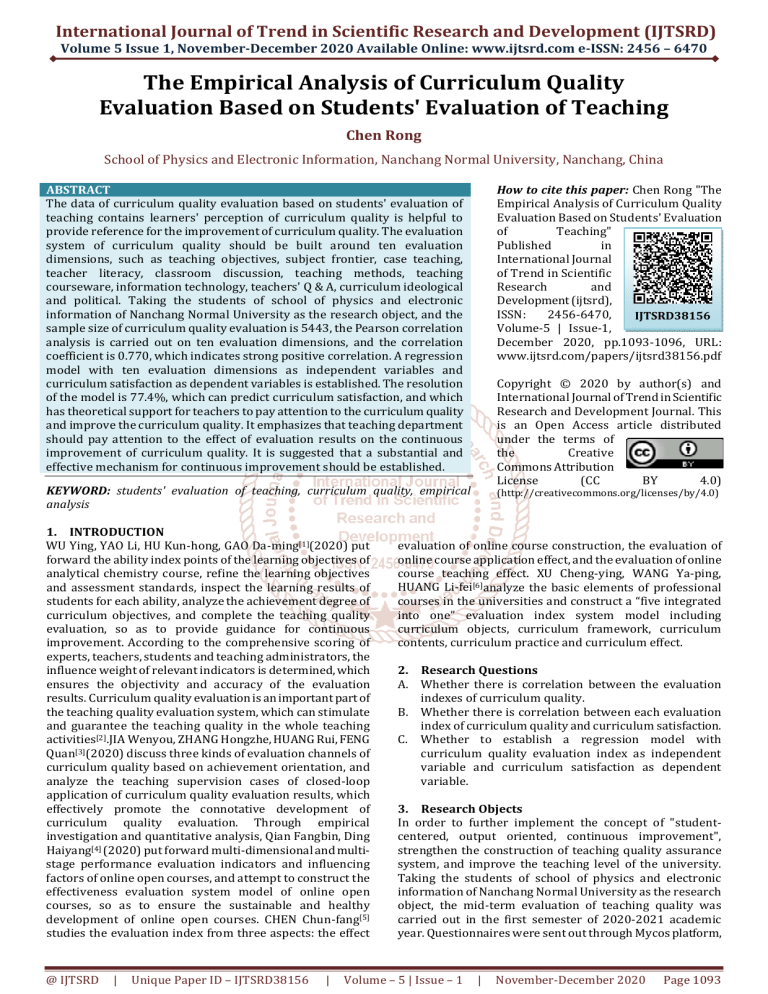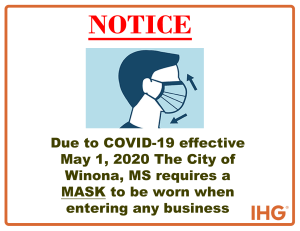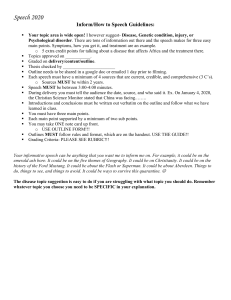
International Journal of Trend in Scientific Research and Development (IJTSRD)
Volume 5 Issue 1, November-December 2020 Available Online: www.ijtsrd.com e-ISSN: 2456 – 6470
The Empirical Analysis of Curriculum Quality
Evaluation Based on Students' Evaluation of Teaching
Chen Rong
School of Physics and Electronic Information, Nanchang Normal University, Nanchang, China
ABSTRACT
The data of curriculum quality evaluation based on students' evaluation of
teaching contains learners' perception of curriculum quality is helpful to
provide reference for the improvement of curriculum quality. The evaluation
system of curriculum quality should be built around ten evaluation
dimensions, such as teaching objectives, subject frontier, case teaching,
teacher literacy, classroom discussion, teaching methods, teaching
courseware, information technology, teachers' Q & A, curriculum ideological
and political. Taking the students of school of physics and electronic
information of Nanchang Normal University as the research object, and the
sample size of curriculum quality evaluation is 5443, the Pearson correlation
analysis is carried out on ten evaluation dimensions, and the correlation
coefficient is 0.770, which indicates strong positive correlation. A regression
model with ten evaluation dimensions as independent variables and
curriculum satisfaction as dependent variables is established. The resolution
of the model is 77.4%, which can predict curriculum satisfaction, and which
has theoretical support for teachers to pay attention to the curriculum quality
and improve the curriculum quality. It emphasizes that teaching department
should pay attention to the effect of evaluation results on the continuous
improvement of curriculum quality. It is suggested that a substantial and
effective mechanism for continuous improvement should be established.
How to cite this paper: Chen Rong "The
Empirical Analysis of Curriculum Quality
Evaluation Based on Students' Evaluation
of
Teaching"
Published
in
International Journal
of Trend in Scientific
Research
and
Development (ijtsrd),
ISSN:
2456-6470,
IJTSRD38156
Volume-5 | Issue-1,
December 2020, pp.1093-1096, URL:
www.ijtsrd.com/papers/ijtsrd38156.pdf
KEYWORD: students' evaluation of teaching, curriculum quality, empirical
analysis
(http://creativecommons.org/licenses/by/4.0)
1. INTRODUCTION
WU Ying, YAO Li, HU Kun-hong, GAO Da-ming[1](2020) put
forward the ability index points of the learning objectives of
analytical chemistry course, refine the learning objectives
and assessment standards, inspect the learning results of
students for each ability, analyze the achievement degree of
curriculum objectives, and complete the teaching quality
evaluation, so as to provide guidance for continuous
improvement. According to the comprehensive scoring of
experts, teachers, students and teaching administrators, the
influence weight of relevant indicators is determined, which
ensures the objectivity and accuracy of the evaluation
results. Curriculum quality evaluation is an important part of
the teaching quality evaluation system, which can stimulate
and guarantee the teaching quality in the whole teaching
activities[2].JIA Wenyou, ZHANG Hongzhe, HUANG Rui, FENG
Quan[3](2020) discuss three kinds of evaluation channels of
curriculum quality based on achievement orientation, and
analyze the teaching supervision cases of closed-loop
application of curriculum quality evaluation results, which
effectively promote the connotative development of
curriculum quality evaluation. Through empirical
investigation and quantitative analysis, Qian Fangbin, Ding
Haiyang[4] (2020) put forward multi-dimensional and multistage performance evaluation indicators and influencing
factors of online open courses, and attempt to construct the
effectiveness evaluation system model of online open
courses, so as to ensure the sustainable and healthy
development of online open courses. CHEN Chun-fang[5]
studies the evaluation index from three aspects: the effect
@ IJTSRD
|
Unique Paper ID – IJTSRD38156
|
Copyright © 2020 by author(s) and
International Journal of Trend in Scientific
Research and Development Journal. This
is an Open Access article distributed
under the terms of
the
Creative
Commons Attribution
License
(CC
BY
4.0)
evaluation of online course construction, the evaluation of
online course application effect, and the evaluation of online
course teaching effect. XU Cheng-ying, WANG Ya-ping,
HUANG Li-fei[6]analyze the basic elements of professional
courses in the universities and construct a “five integrated
into one” evaluation index system model including
curriculum objects, curriculum framework, curriculum
contents, curriculum practice and curriculum effect.
2. Research Questions
A. Whether there is correlation between the evaluation
indexes of curriculum quality.
B. Whether there is correlation between each evaluation
index of curriculum quality and curriculum satisfaction.
C. Whether to establish a regression model with
curriculum quality evaluation index as independent
variable and curriculum satisfaction as dependent
variable.
3. Research Objects
In order to further implement the concept of "studentcentered, output oriented, continuous improvement",
strengthen the construction of teaching quality assurance
system, and improve the teaching level of the university.
Taking the students of school of physics and electronic
information of Nanchang Normal University as the research
object, the mid-term evaluation of teaching quality was
carried out in the first semester of 2020-2021 academic
year. Questionnaires were sent out through Mycos platform,
Volume – 5 | Issue – 1
|
November-December 2020
Page 1093
International Journal of Trend in Scientific Research and Development (IJTSRD) @ www.ijtsrd.com eISSN: 2456-6470
and 5443 questionnaires were recovered and 5443 were
valid. The effective rate was 100%.As shown in Table 1, the
respondents are college students, with 11.8% in grade 2017,
25.2% in grade 2018, 26.3% in grade 2019 and 36.7% in
grade 2020.As shown in Table 2, 57.2% of the students
Grade
2017
2018
2019
2020
Total
majored in electronic information engineering, 12.6% in
electronic information engineering technology and 30.2% in
physics. As shown in Table 3, 30.2% of the students are
normal students and 69.8% are non normal students.
Table 1 the Frequency of Grades
Percentage( %) Effective Percentage( %)
11.8
11.8
25.2
25.2
26.3
26.3
36.7
36.7
100.0
100.0
Frequency
642
1372
1434
1995
5443
Cumulative Percentage( %)
11.8
37.0
63.3
100.0
Table 2 the Frequency of Professional
Percentage
Effective
Major
Frequency
Percentage(%)
(%)
electronic information engineering
3114
57.2
57.2
electronic information engineering technology
686
12.6
12.6
physics
1643
30.2
30.2
Total
5443
100.0
100.0
Normal Students
NO
YES
Total
Frequency
3800
1643
5443
Table 3 the Frequency of Normal Students
Percentage(%) Effective Percentage(%)
69.8
69.8
30.2
30.2
100.0
100.0
Cumulative
Percentage ( %)
57.2
69.8
100.0
Cumulative Percentage(%)
69.8
100.0
4. Data Statistics and Analysis
A. Descriptive statistical analysis
It can be seen from table 4 that the average value of teaching objectives is 1.46, between 1 and 2, and the clarity of teaching
objectives is between very clear and clear. The average value of discipline frontier is 1.46, between 1 and 2, and the conformity
degree of discipline frontier is between very consistent and relatively consistent. The average value of case teaching is 1.46,
between 1 and 2, and the help degree of case teaching is between very consistent and relatively consistent. The average value of
teachers' quality such as fluent language expression and easy to understand is 1.47, between 1 and 2, between very consistent
and relatively consistent. The average value of classroom discussion which meets the needs of students is 1.46, between 1 and
2, between very agree and agree. The average value of flexible teaching methods is 1.47, between 1 and 2, between very agree
and agree. The average value of teaching courseware is 1.49, which is between 1 and 2, between very agree and agree. The
average value of information technology is 1.48, between 1 and 2, between very consistent and consistent. The average value of
teachers' Q & A is 1.48, between 1 and 2, between very consistent and relatively consistent. For the degree of help, the average
value of ideological and political education is 1.5, between 1 and 2, between very large and relatively large. The average value of
curriculum satisfaction is 1.47, between 1 and 2, between very satisfied and satisfied.
Mean
N
Standa
rd
Deviat
ion
Minim
al
Value
Maxim
al
Value
Table 4 Descriptive Statistics
Classro Teach Teachi Informa
om
ing
ng
tion
discuss meth
course
technol
ion
od
ware
ogy
1.46
1.47
1.49
1.48
5443
5443
5443
5443
Teachi
ng
objecti
ves
1.46
5443
Subje
ct
front
ier
1.46
5443
1.46
5443
Teac
her
litera
cy
1.47
5443
.655
.653
.651
.653
.655
.655
.666
1
1
1
1
1
1
5
5
5
5
5
5
Case
teac
hing
teach
ers'
Q&A
Curriculum
ideology
and Politics
1.48
5443
1.50
5443
curricul
um
satisfact
ion
1.47
5443
.660
.664
.680
.656
1
1
1
1
1
5
5
5
5
5
B. Reliability and validity analysis
As can be seen from table 5, the coefficient of reliability is 0.979, which is greater than 0.8, which means that the reliability is
good. According to table 6, the value of KMO is 0.976, which is greater than 0.8, and which means that the validity is good.
@ IJTSRD
|
Unique Paper ID – IJTSRD38156
|
Volume – 5 | Issue – 1
|
November-December 2020
Page 1094
International Journal of Trend in Scientific Research and Development (IJTSRD) @ www.ijtsrd.com eISSN: 2456-6470
Table 5Reliability Statistics
Cronbach's Alpha Item
.979
11
Table 6 KMO and Bartlett's test
Measurement of KMO(sampling adequacy)
Approximate chi square
Bartlett's sphericity test
df
Sig.
.976
81590.854
55
.000
C. Pearson correlation analysis
As shown in Table 7, Pearson correlation is significant at the level of 0.01, and the value of correlation coefficient is 0.770,
which indicates strong positive correlation.
Teachi
ng
objecti
ves
Subj
ect
front
ier
Case
teac
hing
Table 7 Pearson correlation
Teac Classro Teac
Teachi
her
om
hing
ng
litera discuss meth course
cy
ion
od
ware
Teaching
1
objectives
Subject
.858**
1
frontier
Case
.834**
.863**
1
teaching
Teacher
.852*
.815**
.826**
1
*
literacy
Classroom
.828*
.794**
.812**
1
.840**
*
discussion
Teaching
.816*
.795**
.826**
.816**
.859**
1
*
method
Teaching
.801*
coursewar
.786**
.811**
.823**
.855**
.813**
*
e
Informatio
.788*
n
.783**
.802**
.807**
.812**
.831**
*
technology
teachers' Q
.806*
.796**
.815**
.817**
.813**
.816**
*
&A
Curriculu
m ideology
.784*
.770**
.793**
.783**
.796**
.794**
*
and
Politics
curriculum
.794*
satisfactio
.779**
.797**
.793**
.797**
.793**
*
n
**. there is a significant correlation at the. 01 level (bilateral).
Informa
tion
technol
ogy
teac
hers'
Q&
A
Curriculu
m ideology
and
Politics
Curricu
lumsati
sfaction
1
.843**
1
.830**
.849**
.799**
.815**
.794**
.806**
1
.825*
*
.822*
*
1
.816**
1
5. Regression Analysis
It can be seen from table 9 that F value in ANOVA is 1865.137 and P value is 0.000, which is less than 0.05, that is, at least one of
the predicted variables has an impact on the dependent variable. It can be seen from table 8 that constant, curriculum
ideological and political education, teaching objectives, teaching courseware, teacher literacy, classroom discussion,
information technology, case teaching, teachers' Q & A, teaching methods, subject frontiers and other predictive variables have
an impact on the dependent variables of curriculum satisfaction. The prediction accuracy of the dependent variables is 77.4%
by using the prediction variables.
It can be seen from table 10 that the P values of the coefficients of predictive variables are all less than 0.05, so the regression
model composed of predictive variables is statistically significant. The model is shown in formula (1)
Y = 0.063 + X 1 ∗ 0.068 + X 2 ∗ 0.042 + X 3 ∗ 0.084 + X 4 * 0.082 + X 5 * 0.081 + X 6 ∗ 0.038 + X 7 ∗ 0.049 + X 8 * 0.108 + X 9 * 0.181 + X 10 * 0.220
(1)
In the formula, X 1 is Teaching objectives, X 2 is Subject frontier, X 3 is Case teaching, X 4 is Teacher literacy, X 5 is Classroom
discussion, X 6 is Teaching method, X 7 is Teaching courseware, X 8 is Information technology, X 9 is Teachers' Q & A, X 10 is
Curriculum ideology and Politics, Y is Curriculum satisfaction.
@ IJTSRD
|
Unique Paper ID – IJTSRD38156
|
Volume – 5 | Issue – 1
|
November-December 2020
Page 1095
International Journal of Trend in Scientific Research and Development (IJTSRD) @ www.ijtsrd.com eISSN: 2456-6470
Model
1
R
.880a
R2
.774
Table 8 Model summaryb
Adjust R2 Error of standard estimation
.774
.312
Durbin-Watson
1.831
A. predictive variables: (constant), Curriculum ideology and Politics, Teaching objectives, Teaching courseware, Teacher
literacy, Classroom discussion, Information technology, Case teaching, teachers' Q & A, Teaching method, Subject frontier.
B. dependent variables: Curriculum satisfaction
1
1.
2.
Model
Regression
residual
total
Table 9 Anovab
Sum of squares
df
mean square
1814.902
10
181.490
528.570
5432
.097
2343.472
5442
Sig.
.000a
predictive variables: (constant), Curriculum ideology and Politics, Teaching objectives, Teaching courseware, Teacher
literacy, Classroom discussion, Information technology,Case teaching, teachers' Q & A, Teaching method, Subject frontier.
dependent variables: Curriculum satisfaction
Model
Table 10 Coefficientsa
Coefficient of non
Standardizatio
standardization
n coefficient
B
Standard error
Beta
.063
.011
.068
.014
.068
.042
.016
.042
.084
.016
.083
.082
.015
.082
.081
.015
.080
.038
.016
.038
.049
.015
.050
.108
.015
.108
.181
.015
.183
(constant)
Teaching objectives
Subject frontier
Case teaching
Teacher literacy
Classroom discussion
1
Teaching method
Teaching courseware
Information technology
teachers' Q & A
Curriculum ideology and
.220
.013
Politics
A. dependent variables: Curriculum satisfaction
.228
6. Conclusion
The evaluation of curriculum quality is not limited to
qualitative analysis. The established regression model can
take corresponding measures to improve the quality of
curriculum. Through intervention or improvement of a
certain evaluation dimension, the quality of curriculum can
be improved. Find out the key factors to improve the quality
of the course. Through the improvement of ideological and
political courses, teachers' Q & A and information
technology, teaching department should focus on the
students' needs and reverse design improvement measures
to improve the quality of the curriculum.
Reference
[1] WU Ying, YAO Li, HU Kun-hong, GAO Da-ming.
Evaluation and Practice on Analytical Chemistry
Course Quality Based on OBE Concept[J].Journal of
Hefei University( Comprehensive Edition),2020,37
(2):140-144
[2]
F
1865.137
Yan Lihong, Shen ruibing, Yang Zhimin, Liu Lili.
Construction and implementation of curriculum
quality evaluation based on OBE concept: a case study
of single chip microcomputer principle and
application [J]. Computer Knowledge and Technology,
@ IJTSRD
|
Unique Paper ID – IJTSRD38156
|
t
Sig.
5.648
4.804
2.656
5.386
5.467
5.338
2.444
3.313
7.305
12.269
.000
.000
.008
.000
.000
.000
.015
.001
.000
.000
17.226 .000
95.0% confidence interval
of B
lower limit
upper limit
.041
.085
.040
.096
.011
.073
.053
.114
.053
.112
.051
.110
.008
.069
.020
.078
.079
.137
.152
.210
.195
.245
16(5):147-148
https://doi.org/10.14004/j.cnki.ckt.2020.0559
[3]
JIA Wenyou, ZHANG Hongzhe, HUANG Rui, FENG
Quan. Research on the Evaluation of Curriculum
Quality in Engineering Universities Based on
Outcome-based Education[J].Journal of HEFEI
University of Technology (Social Sciences), 2020,
34(3):123-128
[4]
Qian Fangbin, Ding Haiyang. Research on the
Construction of Effectiveness Evaluation System of
Open Online Courses Based on Factor Analysis [J].
Shanghai Journal of Educational Evaluation,2020,No.
1:32-36
https://doi.org/10.13794/j.cnki.shjee.2020.0007
[5]
CHEN Chun-fang. Design of Online Course Quality
Assessment Indexes for Application-oriented
Universities [J]. Journal of Jilin Engineering Normal
University, 2020, 36(3):40-43
[6]
XU Cheng-ying, WANG Ya-ping, HUANG Li-fei.
Research on the Quality Evaluation Index of
Professional Curriculum in the Universities of Applied
Sciences[J].Higher Vocational Education—Journal of
Tianjin Vocational Institute,2020,29(2):60-64
Volume – 5 | Issue – 1
|
November-December 2020
Page 1096








